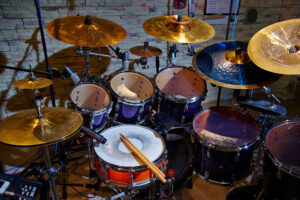 If your child has recently started Denver drum lessons, chances are that you’re about to face the challenge of setting up your very first drum set. This can be tricky since the drum set is not one instrument, it’s several! Proper placement of each part of the drum set is crucial to making sure that your child is able to easily play without having to fight the arrangement of drums and cymbals. The following tips will help you set up your drums in no time!
If your child has recently started Denver drum lessons, chances are that you’re about to face the challenge of setting up your very first drum set. This can be tricky since the drum set is not one instrument, it’s several! Proper placement of each part of the drum set is crucial to making sure that your child is able to easily play without having to fight the arrangement of drums and cymbals. The following tips will help you set up your drums in no time!
Use a Right-Handed Setup
Although it can be tempting to set up your child’s drum set according to which hand is dominant, it is in my opinion better to just set up the kit right handed and a lot of Denver drum teachers will surely agree with this. This will allow for your child to play on most drum sets as the majority of them are set up in this way. Even on a “righty” kit, students can learn to play with their left hand leading everything.
The Throne
The drum throne (another name for the seat) should be high enough that your knees have more than a 90 degree angle when they bend (your knees should be lower than your hips). This will ensure that you can comfortably use your feet to play the two pedaled instruments on the drum set. Which brings us to…
Bass Drum and Hi-Hat
The pedals for your bass drum and hi-hat should be set up so that you can rest your feet comfortably on them in your natural sitting position, without your legs being too close or too far apart. The bass drum is played by the right foot, and the hi-hat by the left foot. Make sure to extend the legs on your bass drum so it doesn’t roll around or slip away!
Snare Drum
Snare placement is important since the stick technique required to play it can be applied to the rest of the drum set as well. The snare goes between your legs when your feet are on the pedals of the bass drum and hi-hat. There’s a goldilocks zone for the height of the snare: The top head should be high enough above your legs so that your arms don’t rest on your legs when you play, but still low enough that your elbows can be low and relaxed instead of high and far from your torso.
The Toms
Although the number of toms can vary between drum sets, most will come with either two or three. One of these is the floor tom, which is the biggest one and goes to the right of the bass drum pedal. Keep the floor tom at roughly the same height as the snare drum and either flat or slightly angled (emphasis on slightly!) towards you.
The other toms are rack toms, which generally attach to the top of the bass drum but occasionally come with their own stands. If you only have one rack tom it goes above the snare drum, angled down slightly so that you can easily reach it. If there are two rack toms, then the smaller one goes above the snare, and the bigger one goes on the right, above the floor tom.
Cymbals
Other than the hi-hat, whose stand we’ve already covered, drum sets tend to come with either one or two cymbals. If there are two cymbals, one will be a ride cymbal and one will be a crash cymbal. The ride goes on the right side, either to the right of and slightly above your lower rack tom, or a little lower and closer to the rest of the kit if you only have one rack tom. Much like the toms, the ride should be angled towards you so can easily play the top of the cymbal. Make sure the cymbal isn’t so high up that you have to lift your arm high to play it!
The crash goes on the left, generally between the hi-hat and high rack tom and higher up than both. Although it can be slightly angled as well, the crash doesn’t need to be as angled as the ride since you’ll tend to hit it on the edge instead of on top. If your drum set only comes with one cymbal, refer to the directions to set up a ride cymbal and use the cymbal you have as both your ride and crash. Most one-cymbal kits tend to have a hybrid crash/ride cymbal built for this very purpose.
Test it Out
Of course, all the instruction in the world doesn’t matter if the kit still feels weird to play! Once the drum set is set up, try it out and adjust heights, positions, and angles as needed. It can also be helpful to look at pictures and videos of other drummers and see if your set up looks generally like theirs. If you’re still stuck or have questions, you can contact us to set up either in person or online and have a professional drummer help you set up your kit!
And if you want to get set up with our music teachers, contact us today! They can either come to your home to teach or can also provide online music lessons. Our virtual music lessons are taught by local music teachers who plan their lessons to suit your child.
By K.R. Azad
